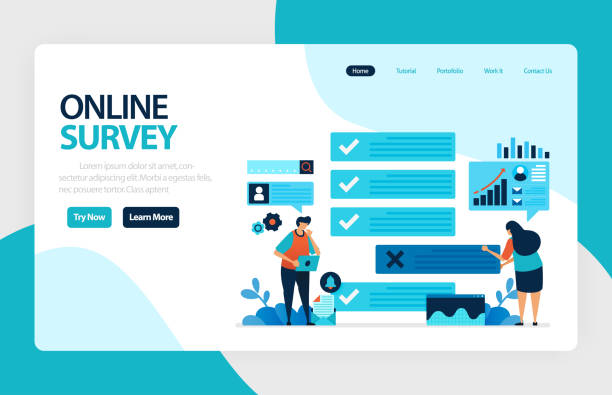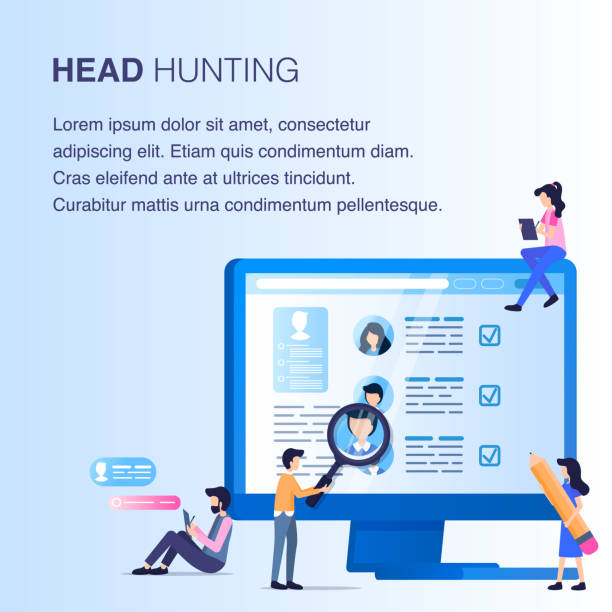Introduction to Responsive Website Design and its Importance

In today’s world, where users access the internet from various devices such as smartphones, tablets, laptops, and even smart TVs, Responsive Web Design is no longer a luxury choice, but a fundamental necessity.
#Responsive_Design refers to an approach in which website design and development are carried out in such a way that web pages automatically adjust their size and layout based on the screen size of the user’s device.
This concept was first introduced by Ethan Marcotte in 2010 and quickly became an industry standard.
Before the advent of Responsive Web Design, developers had to build separate versions for desktop and mobile, which was both costly and difficult to maintain.
The importance of this approach is not limited to visual aesthetics; it directly impacts user experience, SEO, and website conversion rates.
A responsive website ensures that your content is displayed correctly and optimally on any device, without the need for horizontal scrolling or zooming.
This descriptive and analytical approach forms the foundation of modern web.
This responsive web design approach is optimized by considering various device characteristics, including screen resolution, screen size, device orientation, and touch capabilities.
Imagine a user trying to get information from your website on their phone; if your site isn’t responsive, they’ll be forced to awkwardly scroll or zoom to read text or view images, which quickly leads to user frustration and site abandonment.
This is where the importance of teaching the principles of responsive website design becomes even more apparent.
Descriptive and analytical content in this area can help developers build websites that are not only beautiful but also perform excellently.
This is not just a competitive advantage, but an essential need for any business that wants to succeed in today’s digital world and have an effective online presence.
The increasing use of mobile devices has turned this transformation into important news in the web industry.
Are you dissatisfied with the low conversion rate of visitors to customers on your e-commerce site?
With professional e-commerce website design by RasaWeb, solve this problem forever!
✅ Increase visitor-to-customer conversion rate
✅ Create an excellent user experience and build customer trust
⚡ Get free consultation
Key Principles of Responsive Website Design

Responsive website design is built upon solid foundations, the understanding of which is vital for every web developer.
These principles enable a website to adjust its content and layout based on the different characteristics of devices.
The three main pillars of this approach include #Fluid_Grids, #Flexible_Images, and #Media_Queries.
Fluid grids use relative units like percentages for element widths instead of fixed pixels.
This means that the width of a column will always be a specific proportion of the total screen width, regardless of how large or small the screen is.
This approach allows content to scale automatically and fit well into various spaces.
This is a specialized and educational part of the design process.
Flexible images operate in a similar manner.
Instead of fixed pixel dimensions, images are set to a maximum width of 100%, which allows their size to adapt proportionally to the available space within the fluid grid.
This prevents images from being cropped or overflowing the layout, ensuring an excellent visual experience at any screen size.
However, perhaps the most important tool in the responsive website design toolkit is media queries.
Media queries are CSS rules that tell the browser to apply specific styles if certain conditions (such as screen width, orientation, or device type) are met.
For example, you can define that on small screens, columns should stack on top of each other instead of appearing side-by-side, or that font sizes should be reduced.
This specialized capability allows designers to optimize the user experience for each breakpoint.
Learning Media Queries is essential for correctly implementing these principles.
Using these principles ensures that your website will be compatible not only now but also with new devices in the future, providing a sustainable responsive website design.
Advantages of Responsive Website Design for Users and Businesses

Responsive website design is not just a design trend, but a powerful strategy that brings numerous benefits to users and businesses.
One of the most important advantages is improved #User_Experience (UX).
When a site is responsive, users encounter a consistent and easy-to-use interface regardless of the device they are using.
This means simpler navigation, better readability, and reduced need for zooming or horizontal scrolling, ultimately leading to increased user satisfaction and a lower Bounce Rate.
User satisfaction is directly correlated with increased time spent on the site and the likelihood of their return in the future, which in turn means increased engagement and customer loyalty.
This analytical and descriptive aspect demonstrates the true value of responsive website design.
From a business perspective, the benefits of responsive website design are even more prominent.
Firstly, #Search_Engine_Optimization (#SEO) is significantly impacted.
Google has explicitly stated that it prefers responsive websites over separate mobile websites because there is a single URL for content, which is easier for search engines to manage.
This means better ranking in search results and consequently increased organic traffic.
Secondly, reduced costs in maintenance and development are among the other key advantages.
Instead of developing and maintaining two or more versions of a website, there is only one codebase, which saves time and resources.
This is an analytical perspective that shows why this type of website design is important and how it can help save long-term costs.
| Feature | Responsive Website Design | Separate Mobile Website |
|---|---|---|
| Single Codebase | Yes (Integrated) | No (Multiple) |
| SEO (Google Preference) | High (Recommended) | Lower (Harder to Manage) |
| User Experience | Integrated and Consistent | May Vary |
| Maintenance Cost | Lower | Higher |
| Development Complexity | Medium to High (Initially) | Higher (Two Separate Projects) |
Challenges and Solutions for Implementing Responsive Design

Despite its countless advantages, responsive website design also presents its own challenges that must be carefully addressed.
One of the main challenges is #Site_Performance and loading speed.
A responsive website must optimize its content for a wide range of devices with different sizes and capabilities.
Loading high-resolution images for desktop devices on mobile phones with poor connections can lead to very slow loading speeds.
This disrupts the user experience and negatively impacts SEO.
The solution to this problem is to use techniques such as #Responsive_Images with srcset and sizes attributes, or to use CDNs and optimize image compression.
This section provides important guidance for preventing potential issues.
Another challenge in responsive website design is #Website_Testing across various devices.
Since the variety of devices is vast, ensuring that the website displays correctly on all of them can be time-consuming and complex.
Using browser simulation tools, actual tests on physical devices, and cloud testing platforms like BrowserStack can be helpful in this regard.
Content management is also a critical question.
How can content be organized to be equally effective and readable on small and large screens? This is where a strong content strategy is essential for responsive website design.
Content should be modular and adaptable, so it can be easily laid out in different designs.
These guidelines help developers overcome implementation barriers and create a successful responsive site, which includes specialized aspects and thought-provoking content.
Are you lagging behind large online stores in competition?
RasaWeb, with professional e-commerce website design, will bring your business online and increase your market share!
✅ Increase brand credibility and customer trust
✅ Easy shopping experience leads to more sales
⚡ Take action now for a free website design consultation!
Tools and Frameworks for Responsive Development

Implementing responsive website design can be complex and time-consuming without the right tools and frameworks.
Fortunately, the web development community has created a rich set of tools and libraries to simplify this process.
#Bootstrap is one of the most popular and comprehensive CSS frameworks, offering a complete set of pre-built classes for fluid grids, UI components, and JavaScript tools.
Using Bootstrap allows developers to quickly create responsive layouts with minimal custom coding.
This framework is widely used for building responsive website design in both large and small projects and serves as practical guidance for developers.
In addition to Bootstrap, frameworks like #Tailwind_CSS have also gained increasing popularity.
Tailwind adopts a different approach, offering a large collection of utility classes instead of pre-built components, which allows you to build your UI directly in HTML.
This flexibility is ideal for projects requiring highly customized designs.
Other tools such as Sass (Syntactically Awesome Style Sheets) enable developers to organize their CSS with variables, functions, and nested rules, which makes maintaining complex CSS code for responsive website design easier.
Furthermore, browser developer tools (like Inspect Element in Chrome or Firefox), which have the capability to simulate different devices, are essential for debugging and testing responsive designs.
The choice of the right tool depends on the specific project needs and the development team’s preferences, but all of them are designed to facilitate and improve the process of building responsive websites and address the specialized aspect of this work.
The Role of Responsive Design in SEO and Mobile-First Indexing

In the current era, the importance of #Responsive_Website_Design extends beyond aesthetics and user experience, directly impacting #SEO and how websites are indexed by search engines, especially Google.
Since 2018, Google has extensively implemented its #Mobile-First_Indexing policy.
This means that Google’s bots primarily examine the mobile version of your site to crawl and index its content.
If your website is not responsive or has a poor mobile version, you may face issues in search result rankings.
Responsive website design, by providing a single URL and a shared codebase for all devices, greatly simplifies SEO management and helps Google understand and rank your content more effectively.
This is important and analytical news in the field of SEO.
Responsive website design prevents duplicate content issues that might arise if a separate mobile version exists.
Additionally, responsive websites have lower bounce rates and longer user dwell times because they offer a seamless user experience.
These factors indirectly positively impact SEO rankings.
Furthermore, page loading speed, which is a crucial Google ranking factor, improves in an optimized responsive website design.
Responsive websites effectively utilize speed optimization techniques such as lazy loading images and resource compression.
This analysis shows that investing in responsive web design is a vital step for any online business that wants to succeed in Google searches.
This is not just a recommendation, but a specialized necessity for a powerful online presence.
| Feature | Responsive Website Design | Separate Mobile Website |
|---|---|---|
| Single Codebase | Yes (Integrated) | No (Multiple) |
| SEO (Google Preference) | High (Recommended) | Lower (Harder to Manage) |
| User Experience | Integrated and Consistent | May Vary |
| Maintenance Cost | Lower | Higher |
| Development Complexity | Medium to High (Initially) | Higher (Two Separate Projects) |
The Future of Responsive Website Design and Emerging Trends

The world of web is constantly evolving, and responsive website design is no exception.
The future of this field will see the integration of new trends and advanced technologies that will elevate the user experience to higher levels.
One of these trends is #Adaptive_Loading or conditional renders.
Instead of loading all resources for all devices and then hiding them with CSS, adaptive loading allows only the resources needed for a specific device to be loaded.
This is particularly crucial for improving speed and performance on mobile devices with limited bandwidth and is considered a specialized step in optimizing responsive website design.
#Component-Based_Design is also an approach that is gaining widespread adoption.
With the emergence of frameworks like React, Vue, and Angular, developers can build websites using independent and reusable components.
These components can be designed responsively individually and then combined into different page layouts, which significantly improves flexibility and maintainability.
Furthermore, with advancements in #Artificial_Intelligence and #Machine_Learning, we may see the emergence of tools that automatically optimize responsive designs based on user behavior and device characteristics.
This news promises a future where responsive website design will operate more intelligently and dynamically.
| Trend | Description | Importance for Responsive Design |
|---|---|---|
| Adaptive Loading | Loading only resources needed for a specific device. | Improved loading speed and performance, especially on mobile. |
| Component-Based Design | Building UI with independent and reusable components. | Increased flexibility, modularity, and easier maintenance. |
| CSS Container Queries | Applying styles based on parent size, not viewport. | More precise control over responsiveness at the component level. |
| Dark Mode | Ability to change color theme to dark mode. | Increased customization options and user eye comfort. |
| AI in Design | Using AI for optimizing and generating designs. | Potential for automation and dynamic optimization. |
Successful Examples of Responsive Website Design

To better understand the power and beauty of responsive website design, observing successful examples of websites that have well-implemented these principles can be very inspiring.
These examples demonstrate how a single codebase can deliver flawless user experiences across various devices.
One of the most classic examples is the #Smashing_Magazine website, which has been a pioneer in implementing responsive website design.
Visiting this site and resizing the browser window shows how layouts, images, and fonts smoothly and logically adjust themselves to the available space.
This is an excellent example of a specialized website whose content is easily accessible due to its responsive design, offering an engaging user experience.
Websites like #The_New_York_Times are also prominent examples of large-scale responsive website design.
Given the vast amount of news and multimedia content, managing its display on various devices is a significant challenge that they have successfully overcome.
By using advanced media query techniques and image optimization, they ensure that users, whether on a small smartphone or a large monitor, have an enjoyable reading experience.
Other sample sites, including Airbnb and Dropbox, also demonstrate how responsive design has helped them reach a wider audience and provide a unified user experience across different platforms.
These engaging yet informative examples prove that responsive website design is a golden standard in modern web development and is essential for online success.
Are you lagging behind large online stores in competition?
RasaWeb, with professional e-commerce website design, will bring your business online and increase your market share!
✅ Increase brand credibility and customer trust
✅ Easy shopping experience leads to more sales
⚡ Take action now for a free website design consultation!
Common Mistakes in Responsive Design and How to Avoid Them
![]()
Although responsive website design offers many solutions, this approach is not without common errors that can harm user experience and site performance.
Awareness of these mistakes and #guidance_tips for avoiding them is essential for any web developer or designer.
One of the biggest mistakes is ignoring the #Mobile-First strategy.
Some developers first build the desktop layout and then try to “shrink” it for mobile.
This approach often leads to slow and heavy sites on mobile.
The best way is to design for the smallest screen first and then progressively scale up for larger devices.
This approach ensures that your site is responsively designed from the outset for optimal performance on mobile devices and is considered important instruction.
Another common mistake is the lack of image optimization.
Loading high-resolution images on mobile devices consumes significant bandwidth and drastically reduces loading speed.
Using techniques like srcset and sizes in HTML, or image optimization tools such as Imagemin and TinyPNG to provide appropriate images for each device, is crucial.
Also, many designers define #Breakpoints based on specific devices (like iPhone X or iPad Mini), whereas it’s better for these points to be defined based on the site’s content and layout needs.
This is a thought-provoking topic that requires precision.
Avoiding these mistakes in responsive website design not only helps improve performance but also makes the development process smoother and the final results more professional.
This is an educational and analytical content that provides important tips for a successful responsive website design.
The Impact of Responsive Design on Web Accessibility and Inclusivity

Responsive website design not only impacts user experience and SEO but also plays a vital role in improving #Accessibility and web inclusivity.
Accessibility means that your website is usable for people with different abilities (including people with disabilities).
A properly implemented responsive website is naturally more accessible because its layout and content adapt to the diverse needs of users and assistive devices (such as screen readers or braille displays).
For example, in a responsive design, content is organized so that even if a user uses a small screen with high magnification, the text remains readable and navigable.
This is an explanatory dimension of the importance of responsive website design.
By adhering to the principles of responsive website design, such as using relative units for fonts (rem or em), it is ensured that texts remain readable at any screen size and users can change the font size without disrupting the overall site layout.
Additionally, the semantic structure of HTML5, along with WCAG guidelines (Web Content Accessibility Guidelines), enables the creation of an inclusive experience.
A good responsive website design ensures that navigation elements and buttons are sufficiently large and clickable (or tappable) on any screen size.
This is very important for users who may have motor impairments.
This aspect of responsive website design demonstrates a commitment to creating an open and inclusive web for everyone and is considered not just a technical feature, but a social responsibility.
This specialized and educational aspect emphasizes the importance of web inclusivity.
Frequently Asked Questions
| Question | Answer |
|---|---|
| What is responsive website design? | A web design approach where the site adapts to the screen size of various devices (desktop, tablet, mobile). |
| Why is responsive design important? | To provide an optimal user experience on any device the user uses and to improve SEO. |
| What are the main techniques of responsive design? | Using flexible grids, flexible images, and Media Queries. |
| What is a Media Query? | A CSS rule that allows applying different styles based on screen characteristics (like width or height). |
| What are the benefits of responsive website design? | Increased user satisfaction, improved site ranking in search engines (SEO), reduced maintenance costs compared to having separate versions for each device. |
And other advertising services from RasaWeb Advertising Agency
Smart Social Media: A quick and efficient solution for user engagement with a focus on precise audience targeting.
Smart Customer Journey Map: A combination of creativity and technology to increase sales through custom programming.
Smart Customer Journey Map: An effective tool for increasing website traffic by utilizing real data.
Smart UI/UX: Designed for businesses looking to increase click-through rates through marketing automation.
Smart Conversion Rate Optimization: A dedicated service for online growth based on the use of real data.
And over a hundred other services in the field of internet advertising, advertising consultation, and organizational solutions.
Internet Advertising | Advertising Strategy | Advertorial
Resources
- Comprehensive Guide to Responsive Design
- Benefits of Responsive Design in Web
- What is Responsive Design?
- Responsive Website Design Tutorial
✅? For your business to shine in the digital space, Rasaweb Afarin Digital Marketing Agency is with you as a companion and supporter, offering innovative and specialized solutions in the field of custom website design.
📍 Tehran, Mirdamad Street, next to Bank Markazi, Southern Kazeroon Alley, Ramin Alley, No. 6



